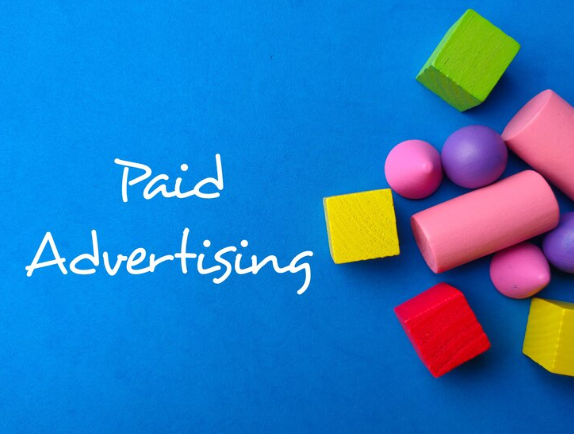Paid advertising is a form of marketing in which businesses pay to have their products or services promoted to a specific audience. This can be done through various channels, such as search engines, social media platforms, websites, and mobile apps.

There are several different types of paid advertising, including:
- Search ads: These appear at the top or bottom of search engine results pages (SERPs) and are triggered by specific keywords that a user searches for.
- Social media ads: These appear in the news feeds or on the sides of social media platforms like Facebook, Instagram, and Twitter. They can be targeted to specific audiences based on factors like age, location, and interests.
- Display ads: These appear on websites and are often in the form of banner ads or native ads (ads that are integrated into the website’s content).
- Mobile app ads: These appear within mobile apps and can be targeted to users based on their app usage and interests.
Overall, paid advertising allows businesses to reach specific audiences and can be an effective way to drive traffic and sales.
The benefits of paid advertising for businesses

- Increased visibility and reach: Paid advertising can help businesses get in front of a larger audience than they might be able to reach organically. For example, a small e-commerce store might not rank well in search engine results for certain keywords, but by running search ads, they can still be found by users searching for those keywords. Similarly, social media ads allow businesses to target specific audiences, which can help them reach a larger group of potential customers.
- Targeted advertising to specific audiences: One of the main benefits of paid advertising is the ability to target specific audiences. For example, a business selling outdoor gear can use demographics and interests to target their ads to users who are interested in hiking and camping. This can help increase the chances that the ad will be seen by people who are more likely to be interested in the product.
- Ability to track and measure effectiveness: Paid advertising platforms often provide detailed analytics and reporting, which can help businesses track the effectiveness of their campaigns. This can include metrics like clicks, conversions, and return on investment (ROI). By tracking these metrics, businesses can see how well their ads are performing and make adjustments as needed.
- Opportunity to test and optimize campaigns: Paid advertising provides the opportunity to test different versions of ads and see which ones perform the best. This can help businesses optimize their campaigns and get the most out of their advertising budget. For example, a business can test different ad copy, visuals, and targeting to see which combination results in the most conversions. Overall, the ability to test and optimize campaigns can help businesses get the most value from their paid advertising efforts.
How to get started with paid advertising
- Determine your advertising goals and budget: The first step in getting started with paid advertising is to determine what you want to achieve and how much you are willing to spend. Do you want to drive more traffic to your website? Increase brand awareness? Make more sales? Having clear goals will help guide your decision-making when it comes to selecting platforms and ad formats. It’s also important to set a budget that you are comfortable with and that aligns with your goals.
- Choose the right platforms and ad formats for your business: There are many different platforms and ad formats to choose from, and the right ones for your business will depend on your goals, target audience, and product or service. For example, if you are selling a physical product, you might consider using Google Shopping Ads to reach users who are actively searching for products online. Or, if you are looking to increase brand awareness, you might consider running display ads on popular websites or using sponsored posts on social media.
- Create compelling ad copy and visuals: Once you have chosen your platforms and ad formats, you’ll need to create the actual ads. This includes writing ad copy that clearly communicates the value of your product or service and designing visuals that grab attention and align with your brand. It’s important to make your ads stand out and give users a reason to click through.
- Set up tracking and measurement tools: To track the effectiveness of your paid advertising campaigns, you’ll need to set up tracking and measurement tools. This can include using built-in analytics provided by the advertising platform or integrating with external tools like Google Analytics. By tracking metrics like clicks, conversions, and ROI, you can see how well your ads are performing and make adjustments as needed.
Tips for successful paid advertising campaigns

- Research and understand your target audience: Before launching a paid advertising campaign, it’s important to have a clear understanding of your target audience. This includes factors like demographics, interests, pain points, and behaviors. By understanding your audience, you can create ads that are more likely to resonate with them and be effective.
- Use A/B testing to optimize your ads: A/B testing, also known as split testing, involves creating two or more versions of an ad and seeing which one performs better. This can be done for different elements of the ad, such as the headline, body copy, visuals, and targeting. By using A/B testing, you can identify which elements of your ads are most effective and optimize your campaigns accordingly.
- Monitor and adjust your campaigns regularly: Paid advertising campaigns should not be set and forgotten. It’s important to regularly monitor your campaigns and make adjustments as needed. This can include adjusting your targeting, ad copy, and budget based on the performance of your ads. By continuously monitoring and adjusting your campaigns, you can improve their effectiveness over time.
- Utilize re-targeting to stay top-of-mind with interested customers: Re-targeting, also known as retargeting, is a type of paid advertising that allows you to show ads to users who have previously visited your website or interacted with your brand. This can help keep your business top-of-mind with interested customers and increase the chances of converting them into paying customers.
In conclusion, paid advertising is an important part of a comprehensive digital marketing strategy for businesses today. As a digital agency, we can help businesses effectively use paid advertising to drive brand awareness and sales. With the increasing competition in the online marketplace, paid advertising can help businesses stand out and reach specific audiences. By understanding the basics of paid advertising and implementing best practices, businesses can get the most value out of their campaigns and stay ahead of the competition. It’s important to continuously monitor and adjust paid advertising campaigns to ensure their success.



